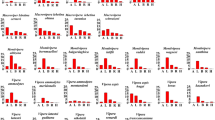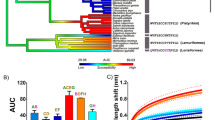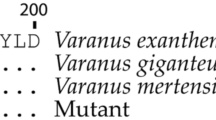Abstract
Ecological variability among closely related species provides an opportunity for evolutionary comparative studies. Therefore, to investigate the origin and evolution of neurotoxicity in Asian viperid snakes, we tested the venoms of Azemiops feae, Calloselasma rhodostoma, Deinagkistrodon acutus, Tropidolaeums subannulatus, and T. wagleri for their relative specificity and potency upon the amphibian, lizard, bird, rodent, and human α-1 (neuromuscular) nicotinic acetylcholine receptors. We utilised a biolayer interferometry assay to test the binding affinity of these pit viper venoms to orthosteric mimotopes of nicotinic acetylcholine receptors binding region from a diversity of potential prey types. The Tropidolaemus venoms were much more potent than the other species tested, which is consistent with the greater prey escape potential in arboreal niches. Intriguingly, the venom of C. rhodostoma showed neurotoxic binding to the α-1 mimotopes, a feature not known previously for this species. The lack of prior knowledge of neurotoxicity in this species is consistent with our results due to the bias in rodent studies and human bite reports, whilst this venom had a greater binding affinity toward amphibian and diapsid α-1 targets. The other large terrestrial species, D. acutus, did not display any meaningful levels of neurotoxicity. These results demonstrate that whilst small peptide neurotoxins are a basal trait of these snakes, it has been independently amplified on two separate occasions, once in Azemiops and again in Tropidolaemus, and with Calloselasma representing a third possible amplification of this trait. These results also point to broader sources of novel neuroactive peptides with the potential for use as lead compounds in drug design and discovery.


Similar content being viewed by others
References
Abbott NJ, Patabendige AA, Dolman DE, Yusof SR, Begley DJ (2010) Structure and function of the blood–brain barrier. Neurobiol Dis 37:13–25
Alencar LR, Quental TB, Grazziotin FG, Alfaro ML, Martins M, Venzon M, Zaher H (2016) Diversification in vipers: phylogenetic relationships, time of divergence and shifts in speciation rates. Mol Phylogenet Evol 105:50–62
Ali SA et al (2013) Proteomic comparison of Hypnale hypnale (hump-nosed pit-viper) and Calloselasma rhodostoma (Malayan pit-viper) venoms. J Proteome 91:338–343
Barber CM, Isbister GK, Hodgson WC (2013) Alpha neurotoxins. Toxicon 66:47–58
Bracci L, Lozzi L, Lelli B, Pini A, Neri P (2001) Mimotopes of the nicotinic receptor binding site selected by a combinatorial peptide library. Biochemistry 40:6611–6619
Bracci L et al (2002) A branched peptide mimotope of the nicotinic receptor binding site is a potent synthetic antidote against the snake neurotoxin α-bungarotoxin. Biochemistry 41:10194–10199
Brust A et al (2013) Differential evolution and neofunctionalization of snake venom metalloprotease domains. Mol Cell Probes 12:651–663
Chiappinelli VA, Weaver WR, McLane KE, Conti-Fine BM, Fiordalisi JJ, Grant GA (1996) Binding of native κ-neurotoxins and site-directed mutants to nicotinic acetylcholine receptors. Toxicon 34:1243–1256
da Silva NJ Jr, Aird SD (2001) Prey specificity, comparative lethality and compositional differences of coral snake venoms. Comp Biochem Physiol, Part C: Toxicol Pharmacol 128:425–456
Das I, Charles JK (2015) Venomous snakes and envenomation in Brunei. In: Gopalakrishnakone P (ed) Clinical Toxinology in Asia Pacific and Africa. Springer Science, pp 103–114
Dashevsky D, Fry BG (2018) Ancient diversification of three-finger toxins in Micrurus coral snakes. J Mol Evol 86:58–67
Davies E-L, Arbuckle K (2019) Coevolution of snake venom toxic activities and diet: evidence that ecological generalism favours toxicological diversity. Toxins 11:711
Debono J, Xie B, Violette A, Fourmy R, Jaeger M, Fry BG (2017) Viper venom botox: the molecular origin and evolution of the waglerin peptides used in anti-wrinkle skin cream. J Mol Evol 84:8–11
Debono J, Bos MH, Coimbra F, Ge L, Frank N, Kwok HF, Fry BG (2019) Basal but divergent: clinical implications of differential coagulotoxicity in a clade of Asian vipers. Toxicol in Vitro 58:195–206
Fry BG (2005) From genome to “venome”: molecular origin and evolution of the snake venom proteome inferred from phylogenetic analysis of toxin sequences and related body proteins. Genome Res 15:403–420
Fry BG, Wüster W, Ryan Ramjan SF, Jackson T, Martelli P, Kini RM (2003) Analysis of Colubroidea snake venoms by liquid chromatography with mass spectrometry: evolutionary and toxinological implications. Rapid Commun Mass Spectrom 17:2047–2062
Gotti C, Clementi F (2004) Neuronal nicotinic receptors: from structure to pathology. Prog Neurobiol 74:363–396
Harris RJ, Zdenek CN, Harrich D, Frank N, Fry BG (2020) An appetite for destruction: Detecting prey-selective binding of α-neurotoxins in the venom of Afro-Asian elapids. Toxins 12(3):205
Hsiao Y-M, Chuang C-C, Chuang L-C, Yu H-M, Wang K-T, Chiou S-H, Wu S-H (1996) Protein engineering of venom toxins by synthetic approach and NMR dynamic simulation: status of basic amino acid residues in waglerin I. Biochem Biophys Res Commun 227:59–63
Jackson T et al (2013) Venom down under: dynamic evolution of Australian elapid snake toxins. Toxins 5:2621–2655
Katchalski-Katzir E, Kasher R, Balass M, Scherf T, Harel M, Fridkin M, Sussman JL, Fuchs S (2002) Design and synthesis of peptides that bind α-bungarotoxin with high affinity and mimic the three-dimensional structure of the binding-site of acetylcholine receptor. Biophys Chem 100:293–305
Le Novere N, Changeux J-P (1995) Molecular evolution of the nicotinic acetylcholine receptor: an example of multigene family in excitable cells. J Mol Evol 40:155–172
Lin W, Smith L, Lee C (1995) A study on the cause of death due to waglerin-I, a toxin from Trimeresurus wagleri. Toxicon 33:111–114
Lyons K, Dugon MM, Healy K (2020) Diet breadth mediates the prey specificity of venom potency in snakes. Toxins 12(2):74
McArdle JJ, Lentz TL, Witzemann V, Schwarz H, Weinstein SA, Schmidt JJ (1999) Waglerin-1 selectively blocks the epsilon form of the muscle nicotinic acetylcholine receptor. J Pharmacol Exp Ther 289:543–550
McLane KE, Wu X, Diethelm B, Conti-Tronconi BM (1991) Structural determinants of α-bungarotoxin binding to the sequence segment 181-200 of the muscle nicotinic acetylcholine receptor. α-subunit: effects of cysteine/cystine modification and species-specific amino acid substitutions. Biochemistry 30:4925–4934
McLane KE, Wu X, Conti-Tronconi BM (1994) An α-bungarotoxin-binding sequence on the Torpedo nicotinic acetylcholine receptor α-subunit: conservative amino acid substitutions reveal side-chain specific interactions. Biochemistry 33:2576–2585
Molles BE, Rezai P, Kline EF, McArdle JJ, Sine SM, Taylor P (2002a) Identification of residues at the α and ε subunit interfaces mediating species selectivity of Waglerin-1 for nicotinic acetylcholine receptors. J Biol Chem 277:5433–5440
Molles BE, Tsigelny I, Nguyen PD, Gao SX, Sine SM, Taylor P (2002b) Residues in the ε subunit of the nicotinic acetylcholine receptor interact to confer selectivity of Waglerin-1 for the α− ε subunit interface site. Biochemistry 41:7895–7906
Nielsen VG (2016) Ancrod revisited: viscoelastic analyses of the effects of Calloselasma rhodostoma venom on plasma coagulation and fibrinolysis. J Thromb Thrombolysis 42:288–293
Nielsen VG, Frank N (2018) Differential heme-mediated modulation of Deinagkistrodon, Dispholidus, Protobothrops and Pseudonaja hemotoxic venom activity in human plasma. Biometals 31:951–959
Nirthanan S, Gwee MC (2004) Three-finger α-neurotoxins and the nicotinic acetylcholine receptor, forty years on. J Pharmacol Sci 94:1–17
Orlov N, Ananjeva N, Khalikov R (2002) Natural history of pitvipers in Eastern and Southeastern Asia. Biol Vipers 345–361
Pawlak J, Mackessy SP, Fry BG, Bhatia M, Mourier G, Fruchart-Gaillard C, Servent D, Ménez R, Stura E, Ménez A, Kini RM (2006) Denmotoxin, a three-finger toxin from the colubrid snake Boiga dendrophila (mangrove catsnake) with bird-specific activity. J Biol Chem 281:29030–29041
Pawlak J et al (2009) Irditoxin, a novel covalently linked heterodimeric three-finger toxin with high taxon-specific neurotoxicity. FASEB J 23:534–545
Rokyta DR, Wray KP, Margres MJ (2013) The genesis of an exceptionally lethal venom in the timber rattlesnake (Crotalus horridus) revealed through comparative venom-gland transcriptomics. BMC Genomics 14:394
Rokyta DR, Wray KP, McGivern JJ, Margres MJ (2015) The transcriptomic and proteomic basis for the evolution of a novel venom phenotype within the timber rattlesnake (Crotalus horridus). Toxicon 98:34–48
Schmidt JJ, Weinstein SA (1995) Structure-function studies of waglerin I, a lethal peptide from the venom of Wagler’s pit viper, Trimeresurus wagleri. Toxicon 33:1043–1049
Schmidt JJ, Weinstein SA, Smith LA (1992) Molecular properties and structure-function relationships of lethal peptides from venom of Wagler’s pit viper, Trimeresurus wagleri. Toxicon 30:1027–1036
Tan CH, Tan KY, Yap MKK, Tan NH (2017) Venomics of Tropidolaemus wagleri, the sexually dimorphic temple pit viper: unveiling a deeply conserved atypical toxin arsenal. Sci Rep 7:43237
Tang ELH, Tan CH, Fung SY, Tan NH (2016) Venomics of Calloselasma rhodostoma, the Malayan pit viper: a complex toxin arsenal unraveled. J Proteome 148:44–56
Testai FD, Venera GD, Peña C, de Jiménez Bonino MJB (2000) Histidine 186 of the nicotinic acetylcholine receptor α subunit requires the presence of the 192–193 disulfide bridge to interact with α-bungarotoxin. Neurochem Int 36:27–33
Tsai M-C, Hsieh W, Smith L, Lee C (1995) Effects of waglerin-I on neuromuscular transmission of mouse nerve-muscle preparations. Toxicon 33:363–371
Tzartos S, Remoundos MS (1990) Fine localization of the major alpha-bungarotoxin binding site to residues alpha 189-195 of the Torpedo acetylcholine receptor. Residues 189, 190, and 195 are indispensable for binding. J Biol Chem 265:21462–21467
Utkin YN, Weise C, Anh HN, Kasheverov I, Starkov V, Tsetlin V (2012a) The new peptide from the Fea’s viper Azemiops feae venom interacts with nicotinic acetylcholine receptors. In: Doklady biochemistry and biophysics, vol 442. vol 1. Springer Science, pp 33–35
Utkin YN, Weise C, Kasheverov IE, Andreeva TV, Kryukova EV, Zhmak MN, Starkov VG, Hoang NA, Bertrand D, Ramerstorfer J, Sieghart W, Thompson AJ, Lummis SCR, Tsetlin VI (2012b) Azemiopsin from Azemiops feae viper venom, a novel polypeptide ligand of nicotinic acetylcholine receptor. J Biol Chem 287:27079–27086
Withana M, Rodrigo C, Gnanathasan A, Gooneratne L (2014) Presumptive thrombotic thrombocytopenic purpura following a hump-nosed viper (Hypnale hypnale) bite: a case report. J Venomous Anim Toxins Incl Trop Dis 20:26
Zdenek CN et al (2019) A taxon-specific and high-throughput method for measuring ligand binding to nicotinic acetylcholine receptors. Toxins 11:600
Funding
RJH and CNZ was supported by the University of Queensland International PhD scholarship fund. BGF was funded by Australian Research Council Discovery Project DP190100304.
Author information
Authors and Affiliations
Contributions
Conceptualisation: BGF; methodology: RJH, CNZ, BGF; investigation: RJH, JD; resources: JD, DH, BGF; writing of first draft: RJH; editing subsequent drafts; RJH, CNZ, BGF; project administration: BGF.
Corresponding author
Additional information
Publisher’s Note
Springer Nature remains neutral with regard to jurisdictional claims in published maps and institutional affiliations.
Rights and permissions
About this article
Cite this article
Harris, R.J., Zdenek, C.N., Debono, J. et al. Evolutionary Interpretations of Nicotinic Acetylcholine Receptor Targeting Venom Effects by a Clade of Asian Viperidae Snakes. Neurotox Res 38, 312–318 (2020). https://doi.org/10.1007/s12640-020-00211-2
Received:
Revised:
Accepted:
Published:
Issue Date:
DOI: https://doi.org/10.1007/s12640-020-00211-2




